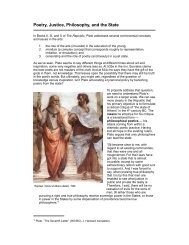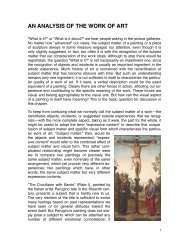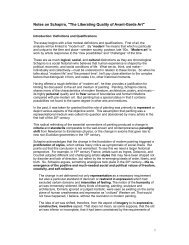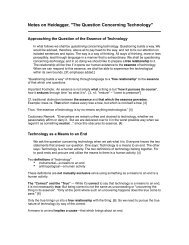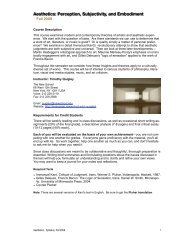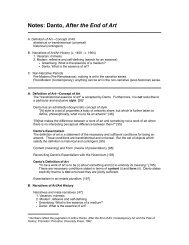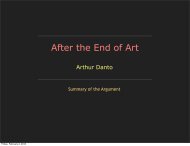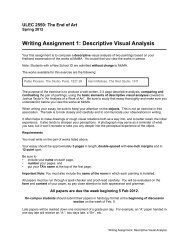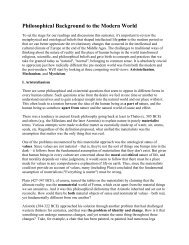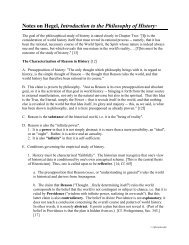Create successful ePaper yourself
Turn your PDF publications into a flip-book with our unique Google optimized e-Paper software.
Things with independent, externalexistence.it is because they do not completely hide each other. Thus I see each thing outside theothers, according to a width measured differently.[24] We are [as Cartesians] always onthe hither side of depth, or beyond it. It is never the case that things really are one behindthe other. The encroachment <strong>and</strong> latency do not enter into their definition. They expressonly my incomprehensible solidarity with one of them—my body; <strong>and</strong> by their positivitythey are thoughts of mine <strong>and</strong> not attributes of things. I know that at this very momentanother person, situated elsewhere—or better, God, who is everywhere—could penetratetheir hiding place <strong>and</strong> see them openly deployed. What I call depth is either nothing, orelse it is my participation in a Being without restriction, first <strong>and</strong> foremost a participation inthe being of space beyond every particular point of view. Things encroach upon oneanother because they are outside one another. The proof of this is that I can see depth ina painting which everyone agrees has none <strong>and</strong> which organizes for me an illusion of anillusion…. This two-dimensional being,[25] which makes me see a third, is a being that ispierced [troué]—as the men of the Renaissance said, a window…. But in the finalanalysis the window opens only upon partes extra partes, upon height <strong>and</strong> breadthmerely seen from another angle—upon the absolute positivity of Being.It is this space without hiding places which in each of its points is only what it is, neithermore nor less, this identity of Being that underlies the analysis of engravings. Space is initself; rather, it is the in-itself par excellence. Its definition is to be in itself. Every point ofspace is, <strong>and</strong> is thought as being, right where it is—one here, another there; space is theself-evidence of the "where." Orientation, polarity, envelopment are, in space, derivedphenomena linked to my presence. Space remains absolutely in itself, everywhere equalto itself, homogeneous; its dimensions, for example, are by definition interchangeable.Like all classical ontologies, this one elevates certain properties of beings into a structureof Being, <strong>and</strong> in so doing it is both true <strong>and</strong> false. Reversing Leibniz's remark, we mightsay that it is true in what it denies <strong>and</strong> false in what it affirms. Descartes's space is true,when contrasted with a thought too empirically dominated, which dares not construct. Itwas necessary first to idealize space, to conceive of that being—perfect of its kind, clear,manageable, <strong>and</strong> homogeneous—which an unsituated thinking glides over without avantage point of its own: a being which thought transcribes in its entirety onto three rightangledaxes—so that subsequent thinkers could one day experience the limitations ofthat construction <strong>and</strong> underst<strong>and</strong> that space does not have precisely three dimensions,(as an animal has either four or two legs), <strong>and</strong> that dimensions are taken by differentsystems of measurement from a single dimensionality, a polymorphous Being, whichjustifies all of them without being fully expressed by any. Descartes was right in liberatingspace: his mistake was to erect it into a positive being, beyond all points of view, alllatency <strong>and</strong> depth, devoid of any real thickness.He was also right in taking his inspiration from the perspectival techniques of theRenaissance; they encouraged painting to experiment freely with depth <strong>and</strong> thepresentation of Being in general. These techniques were false only in that they presumedto bring an end to painting's quest <strong>and</strong> history, to found once <strong>and</strong> for all an exact <strong>and</strong>infallible art of painting. As Panofsky has shown concerning the men of the Renaissance,this enthusiasm was not without bad faith.[26] The theoreticians tried to forget thespherical visual field of the ancients, their angular perspective which relates the apparentsize not to distance but to the angle from which we see the object. They wanted to forgetwhat they disdainfully called perspectiva naturalis, or communis, in favor of a perspectivaartificialis capable in principle of founding an exact construction. To accredit this myth,they went so far as to expurgate Euclid, omitting from their translations the eighththeorem, which was inconvenient. But the painters knew from experience that notechnique of perspective is an exact solution <strong>and</strong> that there is no projection of the existingworld which respects it in all aspects <strong>and</strong> deserves to become the fundamental law ofpainting. They knew that linear perspective was far from being an ultimate breakthrough;on the contrary, it opened several pathways for painting. For example, the Italians tookthe way of representing the object, but the Northern painters discovered <strong>and</strong> worked outthe formal technique of Hochraum, Nahraum, <strong>and</strong> Schrägraum. Thus plane projection9



